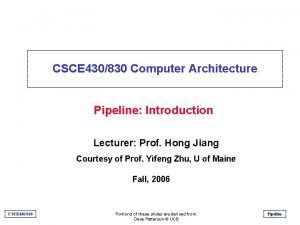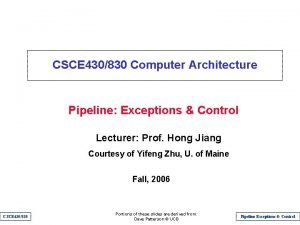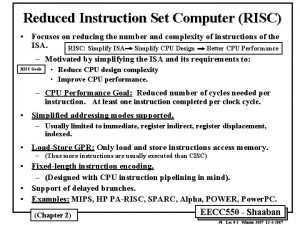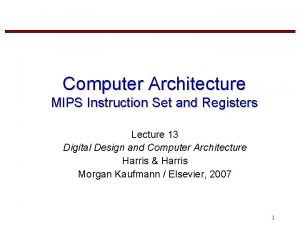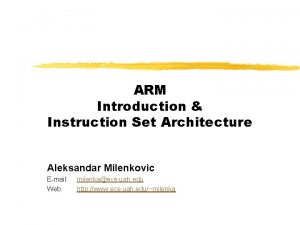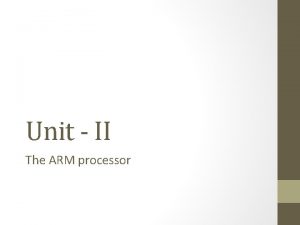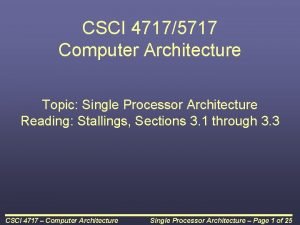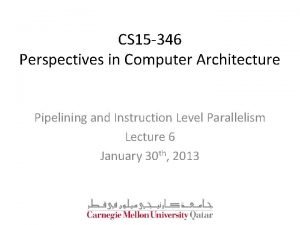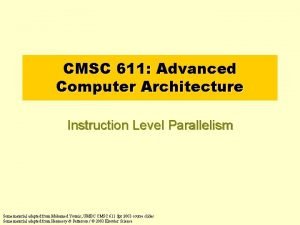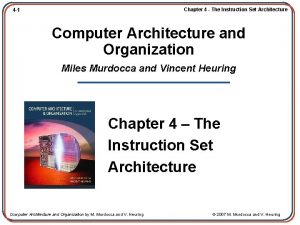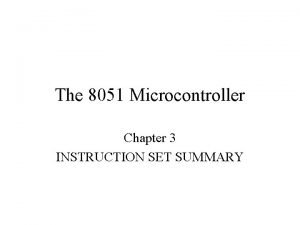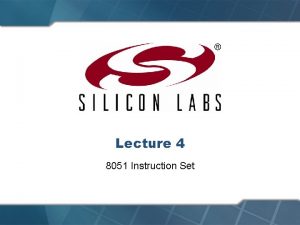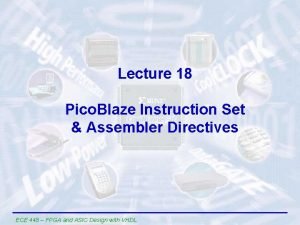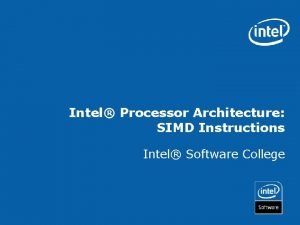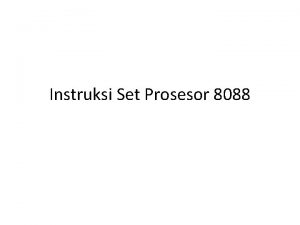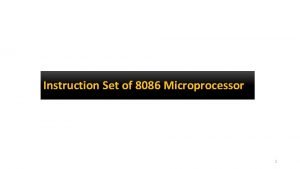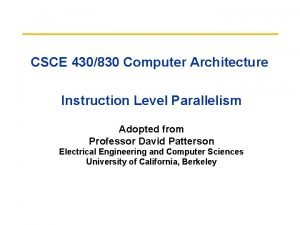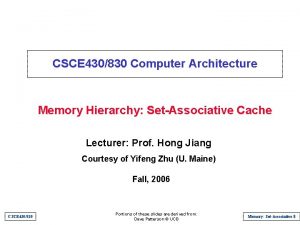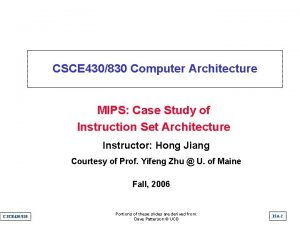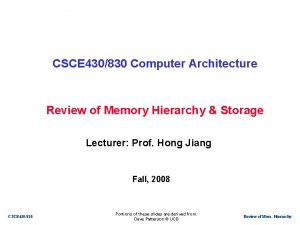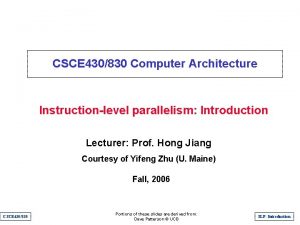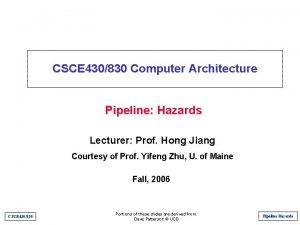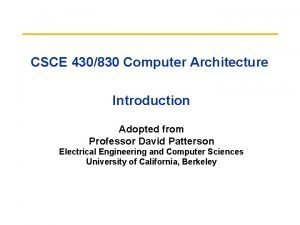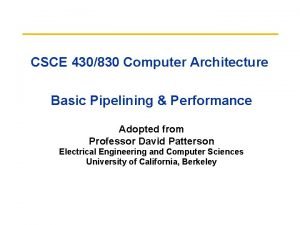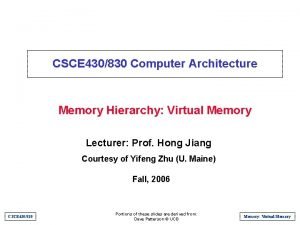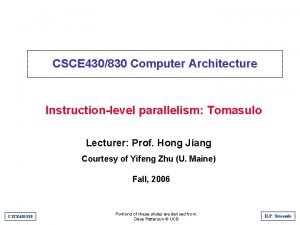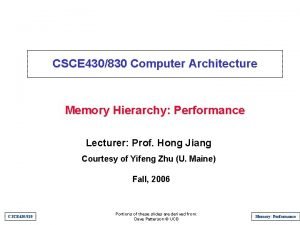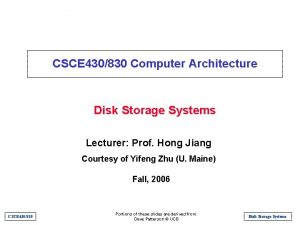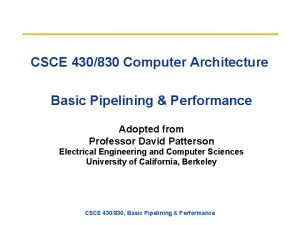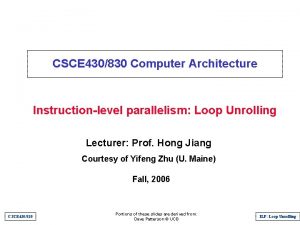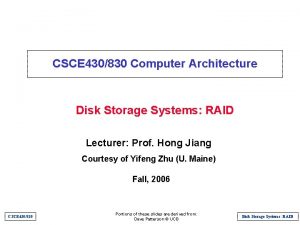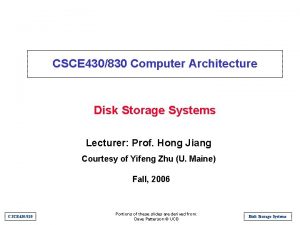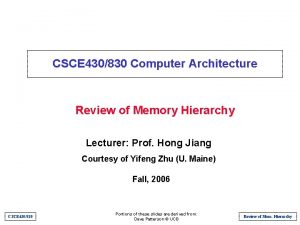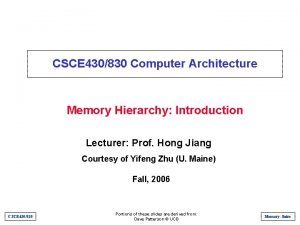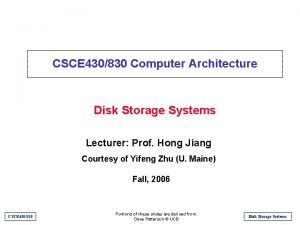CSCE 430830 Computer Architecture Instruction Set Architecture An































- Slides: 31

CSCE 430/830 Computer Architecture Instruction Set Architecture: An Introduction Instructor: Hong Jiang Courtesy of Prof. Yifeng Zhu @ U. of Maine Fall, 2006 CSCE 430/830 Portions of these slides are derived from: Dave Patterson © UCB ISA

Review • Amdahl’s Law: Execution Time without enhancement E 1 Speedup(E) = ----------------------------- = -----------Execution Time with enhancement E (1 - F) + F/S • CPU Time & CPI: CPU time = Instruction count x CPI x clock cycle time CPU time = Instruction count x CPI / clock rate CSCE 430/830 ISA

Outline • Instruction Set Overview – Classifying Instruction Set Architectures (ISAs) – Memory Addressing – Types of Instructions • CSCE 430/830 MIPS Instruction Set (Topic of next lecture) ISA

Instruction Set Architecture (ISA) • Serves as an interface between software and hardware. • Provides a mechanism by which the software tells the hardware what should be done. High level language code : C, C++, Java, Fortran, compiler Assembly language code: architecture specific statements assembler Machine language code: architecture specific bit patterns software instruction set hardware CSCE 430/830 ISA

Interface Design A good interface: • Lasts through many implementations (portability, compatability) • Is used in many different ways (generality) • Provides convenient functionality to higher levels • Permits an efficient implementation at lower levels use use CSCE 430/830 Interface imp 1 time imp 2 imp 3 ISA

Instruction Set Design Issues • Instruction set design issues include: – Where are operands stored? » registers, memory, stack, accumulator – How many explicit operands are there? » 0, 1, 2, or 3 – How is the operand location specified? » register, immediate, indirect, . . . – What type & size of operands are supported? » byte, int, float, double, string, vector. . . – What operations are supported? » add, sub, mul, move, compare. . . CSCE 430/830 ISA

Evolution of Instruction Sets Single Accumulator (EDSAC 1950, Maurice Wilkes) Accumulator + Index Registers (Manchester Mark I, IBM 700 series 1953) Separation of Programming Model from Implementation High-level Language Based (B 5000 1963) Concept of a Family (IBM 360 1964) General Purpose Register Machines Complex Instruction Sets (Vax, Intel 432 1977 -80) CISC Intel x 86, Pentium CSCE 430/830 Load/Store Architecture (CDC 6600, Cray 1 1963 -76) RISC (MIPS, Sparc, HP-PA, IBM RS 6000, Power. PC. . . 1987) ISA

Classifying ISAs Accumulator (before 1960, e. g. 68 HC 11): 1 -address add A acc ¬ acc + mem[A] Stack (1960 s to 1970 s): 0 -address add tos ¬ tos + next Memory-Memory (1970 s to 1980 s): 2 -address 3 -address add A, B mem[A] ¬ mem[A] + mem[B] add A, B, C mem[A] ¬ mem[B] + mem[C] Register-Memory (1970 s to present, e. g. 80 x 86): 2 -address add R 1, A R 1 ¬ R 1 + mem[A] load R 1, A R 1 ¬ mem[A] Register-Register (Load/Store) (1960 s to present, e. g. MIPS): 3 -address add R 1, R 2, R 3 R 1 ¬ R 2 + R 3 load R 1, R 2 R 1 ¬ mem[R 2] store R 1, R 2 mem[R 1] ¬ R 2 CSCE 430/830 ISA

Operand Locations in Four ISA Classes GPR CSCE 430/830 ISA

Code Sequence C = A + B for Four Instruction Sets Stack Accumulator Push A Push B Add Pop C Load A Add B Store C memory CSCE 430/830 acc = acc + mem[C] Register (register-memory) Load R 1, A Add R 1, B Store C, R 1 memory R 1 = R 1 + mem[C] Register (loadstore) Load R 1, A Load R 2, B Add R 3, R 1, R 2 Store C, R 3 = R 1 + R 2 ISA

More About General Purpose Registers • Why do almost all new architectures use GPRs? – Registers are much faster than memory (even cache) » Register values are available immediately » When memory isn’t ready, processor must wait (“stall”) – Registers are convenient for variable storage » Compiler assigns some variables just to registers » More compact code since small fields specify registers (compared to memory addresses) Processor Registers CSCE 430/830 Memory Disk Cache ISA

Stack Architectures • Instruction set: add, sub, mult, div, . . . push A, pop A • Example: A*B - (A+C*B) CSCE 430/830 push A push B mul push A push C push B mul add sub A B A A*B C A A*B B*C A A*B A+B*C result A*B ISA

Stacks: Pros and Cons • Pros – Good code density (implicit top of stack) – Low hardware requirements – Easy to write a simpler compiler for stack architectures • Cons – Stack becomes the bottleneck – Little ability for parallelism or pipelining – Data is not always at the top of stack when need, so additional instructions like TOP and SWAP are needed – Difficult to write an optimizing compiler for stack architectures CSCE 430/830 ISA

Accumulator Architectures • Instruction set: add A, sub A, mult A, div A, . . . load A, store A • Example: A*B - (A+C*B) load B mul C add A store D load A mul B sub D CSCE 430/830 B B*C A+B*C acc = acc +, -, *, / mem[A] A+B*C A A*B result ISA

Accumulators: Pros and Cons • Pros – Very low hardware requirements – Easy to design and understand • Cons – Accumulator becomes the bottleneck – Little ability for parallelism or pipelining – High memory traffic CSCE 430/830 ISA

Memory-Memory Architectures • Instruction set: (3 operands) (2 operands) add A, B, C add A, B sub A, B, C sub A, B mul A, B, C mul A, B • Example: A*B - (A+C*B) – 3 operands mul D, A, B mul E, C, B add E, A, E sub E, D, E CSCE 430/830 2 operands mov D, A mul D, B mov E, C mul E, B add E, A sub E, D ISA

Memory-Memory: Pros and Cons • Pros – Requires fewer instructions (especially if 3 operands) – Easy to write compilers for (especially if 3 operands) • Cons – Very high memory traffic (especially if 3 operands) – Variable number of clocks per instruction – With two operands, more data movements are required CSCE 430/830 ISA

Register-Memory Architectures • Instruction set: add R 1, A load R 1, A sub R 1, A store R 1, A mul R 1, B • Example: A*B - (A+C*B) load R 1, A mul R 1, B store R 1, D load R 2, C mul R 2, B add R 2, A sub R 2, D CSCE 430/830 R 1 = R 1 +, -, *, / mem[B] /* A*B */ /* /* /* C*B */ A + CB */ AB - (A + C*B) */ ISA

Memory-Register: Pros and Cons • Pros – Some data can be accessed without loading first – Instruction format easy to encode – Good code density • Cons – Operands are not equivalent (poor orthogonal) – Variable number of clocks per instruction – May limit number of registers CSCE 430/830 ISA

Load-Store Architectures • Instruction set: add R 1, R 2, R 3 load R 1, &A sub R 1, R 2, R 3 mul R 1, R 2, R 3 store R 1, &A move R 1, R 2 • Example: A*B - (A+C*B) load R 1, &A load R 2, &B load R 3, &C mul R 7, R 3, R 2 add R 8, R 7, R 1 mul R 9, R 1, R 2 sub R 10, R 9, R 8 CSCE 430/830 R 3 = R 1 +, -, *, / R 2 /* /* C*B A + C*B A*B - (A+C*B) */ */ ISA

Load-Store: Pros and Cons • Pros – Simple, fixed length instruction encodings – Instructions take similar number of cycles – Relatively easy to pipeline and make superscalar • Cons – Higher instruction count – Not all instructions need three operands – Dependent on good compiler CSCE 430/830 ISA

Registers: Advantages and Disadvantages • Advantages – – – Faster than cache or main memory (no addressing mode or tags) Deterministic (no misses) Can replicate (multiple read ports) Short identifier (typically 3 to 8 bits) Reduce memory traffic • Disadvantages – – – Need to save and restore on procedure calls and context switch Can’t take the address of a register (for pointers) Fixed size (can’t store strings or structures efficiently) Compiler must manage Limited number Every ISA designed after 1980 uses a load-store ISA (i. e RISC, to simplify CPU design). CSCE 430/830 ISA

Word-Oriented Memory Organization 32 -bit 64 -bit Words • • Memory is byte addressed and provides access for bytes (8 bits), half words (16 bits), words (32 bits), and double words(64 bits). Addresses Specify Byte Locations – Address of first byte in word – Addresses of successive words differ by 4 (32 -bit) or 8 (64 -bit) Addr = 0000 ? ? Addr = 0004 ? ? Addr = 0008 ? ? Addr = 0012 ? ? CSCE 430/830 Addr = 0000 ? ? Addr = 0008 ? ? Bytes Addr. 0000 0001 0002 0003 0004 0005 0006 0007 0008 0009 0010 0011 0012 0013 0014 0015 ISA

Byte Ordering • How should bytes within multi-byte word be ordered in memory? • Conventions – Sun’s, Mac’s are “Big Endian” machines » Least significant byte has highest address – Alphas, PC’s are “Little Endian” machines » Least significant byte has lowest address CSCE 430/830 ISA

Byte Ordering Example • Big Endian – Least significant byte has highest address • Little Endian – Least significant byte has lowest address • Example – Variable x has 4 -byte representation 0 x 01234567 – Address given by &x is 0 x 100 Big Endian 0 x 100 0 x 101 0 x 102 0 x 103 01 Little Endian 45 67 0 x 100 0 x 101 0 x 102 0 x 103 67 CSCE 430/830 23 45 23 01 ISA

Reading Byte-Reversed Listings • Disassembly – Text representation of binary machine code – Generated by program that reads the machine code • Example Fragment Address 8048365: 8048366: 804836 c: Instruction Code 5 b 81 c 3 ab 12 00 00 83 bb 28 00 00 Assembly Rendition pop %ebx add $0 x 12 ab, %ebx cmpl $0 x 0, 0 x 28(%ebx) • Deciphering Numbers – – CSCE 430/830 Value: Pad to 4 bytes: Split into bytes: Reverse: 0 x 12 ab 0 x 000012 ab 00 00 12 ab ab 12 00 00 ISA

Types of Addressing Modes (VAX) Addressing Mode Example Action 1. Register direct Add R 4, R 3 R 4 <- R 4 + R 3 2. Immediate Add R 4, #3 R 4 <- R 4 + 3 3. Displacement Add R 4, 100(R 1) R 4 <- R 4 + M[100 + R 1] 4. Register indirect Add R 4, (R 1) R 4 <- R 4 + M[R 1] 5. Indexed Add R 4, (R 1 + R 2) R 4 <- R 4 + M[R 1 + R 2] 6. Direct Add R 4, (1000) R 4 <- R 4 + M[1000] 7. Memory Indirect Add R 4, @(R 3) R 4 <- R 4 + M[M[R 3]] 8. Autoincrement Add R 4, (R 2)+ R 4 <- R 4 + M[R 2] R 2 <- R 2 + d 9. Autodecrement Add R 4, (R 2)R 4 <- R 4 + M[R 2] R 2 <- R 2 - d 10. Scaled Add R 4, 100(R 2)[R 3] R 4 <- R 4 + M[100 + R 2 + R 3*d] • Studies by [Clark and Emer] indicate that modes 1 -4 account for 93% of all operands on the VAX. CSCE 430/830 ISA

Types of Operations • • CSCE 430/830 Arithmetic and Logic: Data Transfer: Control System Floating Point Decimal String Graphics AND, ADD MOVE, LOAD, STORE BRANCH, JUMP, CALL OS CALL, VM ADDF, MULF, DIVF ADDD, CONVERT MOVE, COMPARE (DE)COMPRESS ISA

80 x 86 Instruction Frequency CSCE 430/830 ISA

Relative Frequency of Control Instructions • Design hardware to handle branches quickly, since these occur most frequently CSCE 430/830 ISA

Summery • Instruction Set Overview – Classifying Instruction Set Architectures (ISAs) – Memory Addressing – Types of Instructions • MIPS Instruction Set (Topic of next class) – Overview – Registers and Memory – Instructions CSCE 430/830 ISA
 Instruction set architecture in computer organization
Instruction set architecture in computer organization Pipeline in computer architecture
Pipeline in computer architecture 430830
430830 430830
430830 Total set awareness set consideration set
Total set awareness set consideration set Training set validation set test set
Training set validation set test set Lmc commands
Lmc commands Cisc complex instruction set computer
Cisc complex instruction set computer Zero instruction set computer
Zero instruction set computer Marie rtl
Marie rtl Instruction set architecture examples
Instruction set architecture examples Mips instruction set architecture
Mips instruction set architecture Arm instruction set architecture
Arm instruction set architecture Which instruction set architecture is used in beaglebone?
Which instruction set architecture is used in beaglebone? Instruction set architecture
Instruction set architecture Mips code
Mips code Instruction format in computer architecture
Instruction format in computer architecture State diagram in computer architecture
State diagram in computer architecture Scalar pipeline in computer architecture
Scalar pipeline in computer architecture Instruction level parallelism in computer architecture
Instruction level parallelism in computer architecture Chapter 4 example
Chapter 4 example Individualized instruction vs differentiated instruction
Individualized instruction vs differentiated instruction Indirect instruction definition
Indirect instruction definition Ax 86s
Ax 86s 8051 boolean processor
8051 boolean processor Computer sic
Computer sic Contoh soal set instruksi 3 alamat
Contoh soal set instruksi 3 alamat Xch instruction in 8051
Xch instruction in 8051 If else statement in assembly language
If else statement in assembly language Intel simd instructions
Intel simd instructions 8088 instruction set
8088 instruction set Instruction set of 8086
Instruction set of 8086

